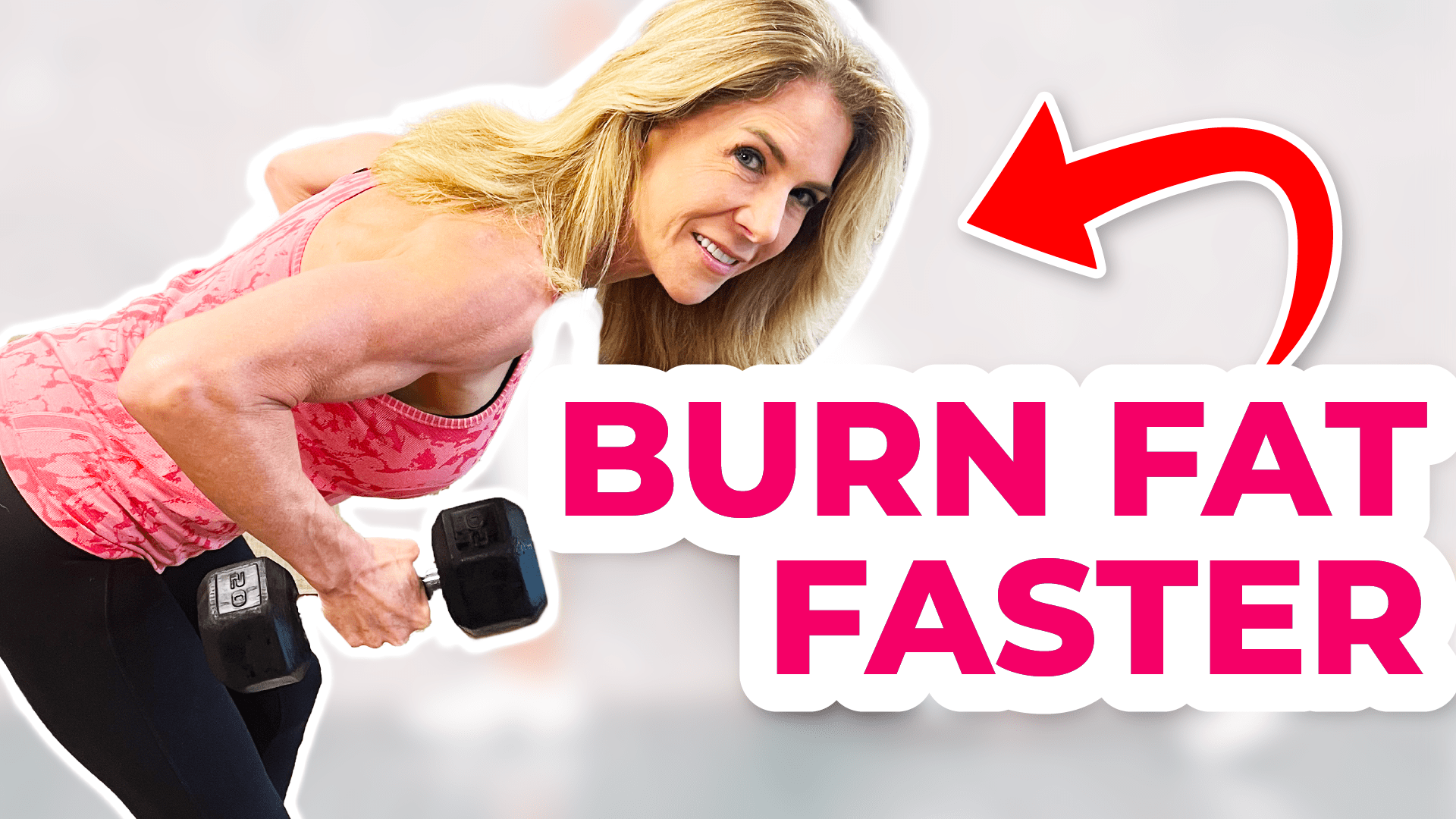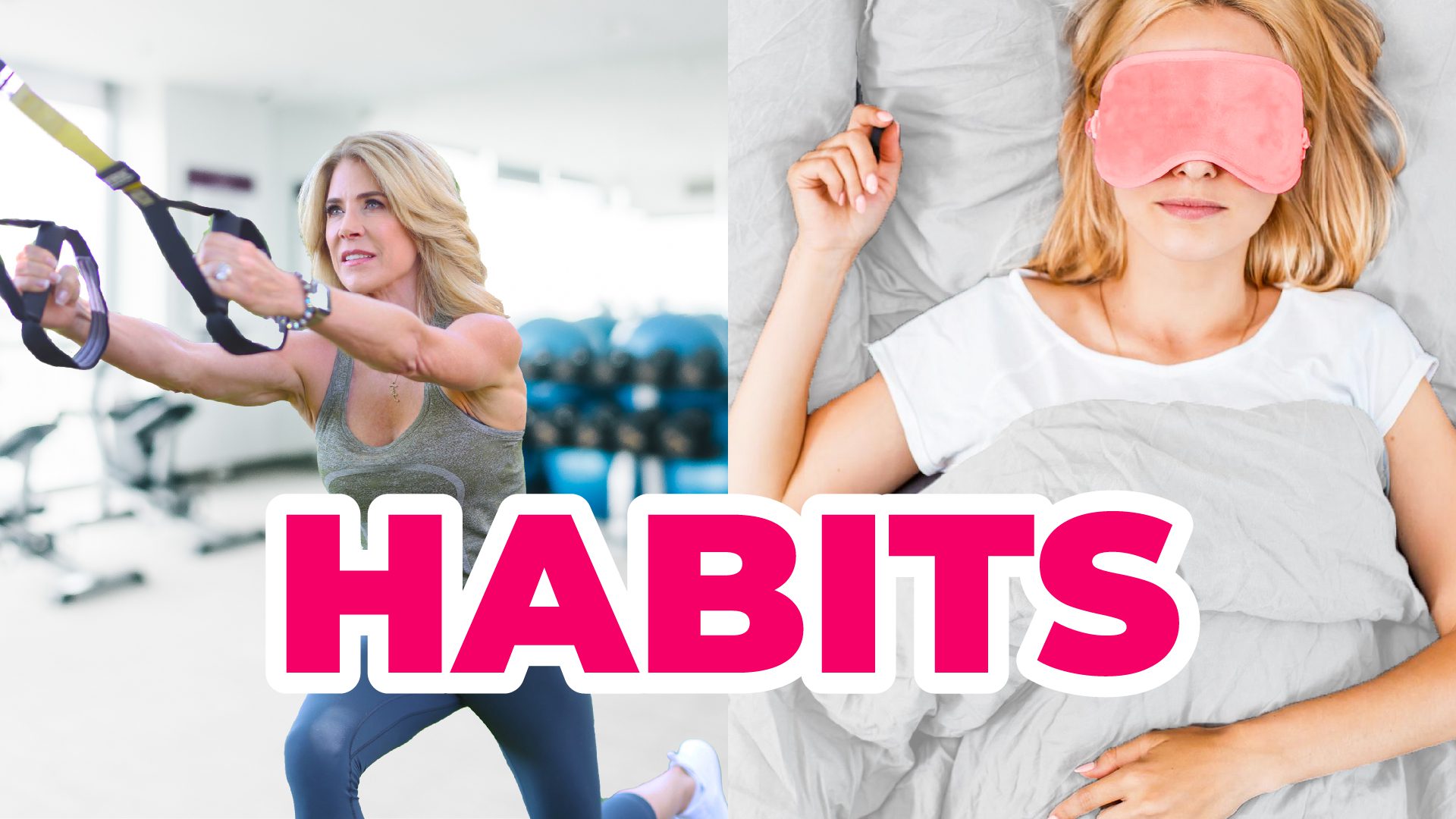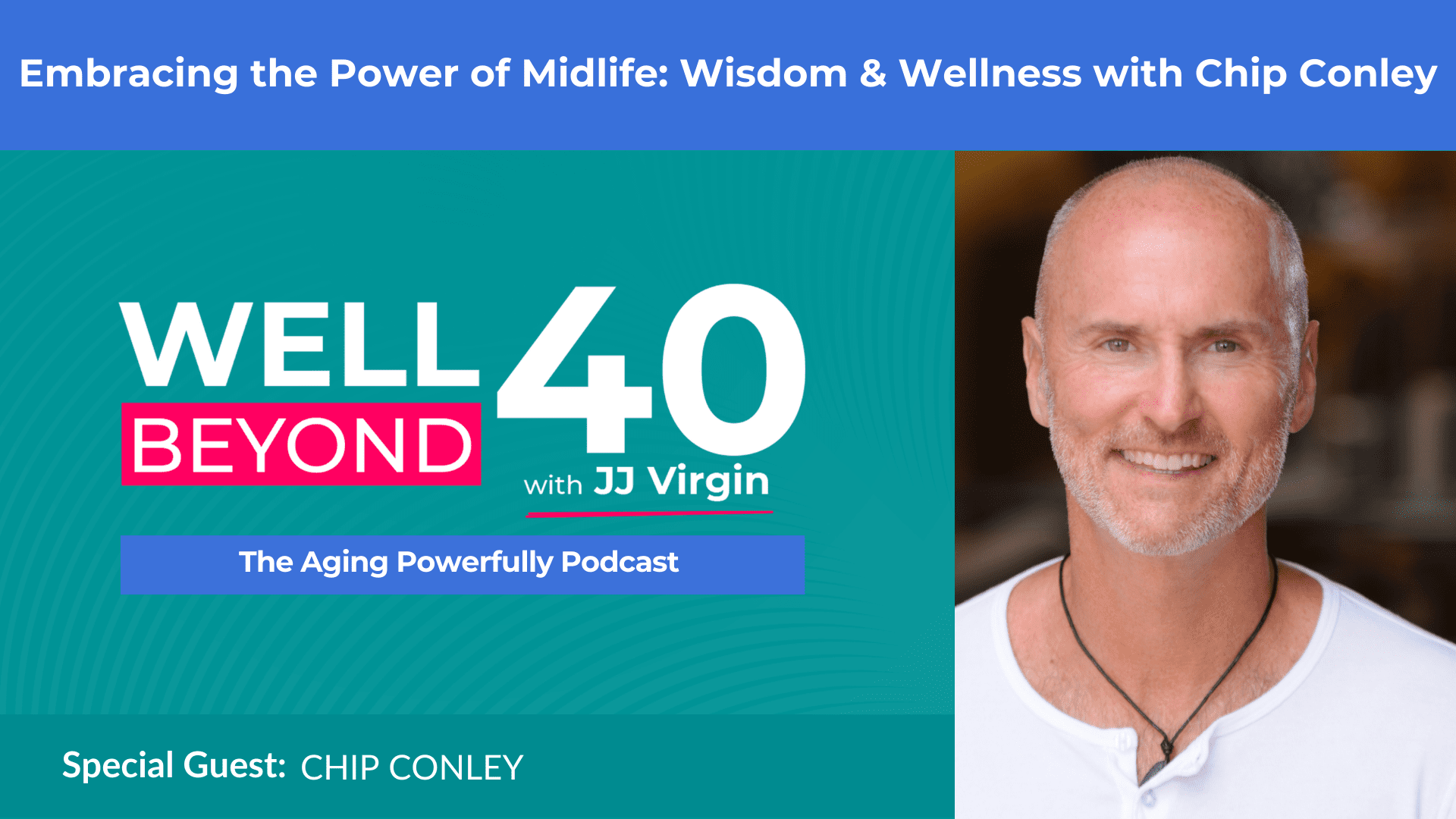How to Get Stronger, Save Time, and See Results
The number one reason people don’t exercise? Time. But what if I told you with just five exercises, you could get stronger, supercharge your fat loss, and start seeing real results?
In this episode, I’m sharing five extremely functional, easy-to-modify exercises you can do anywhere. That’s all you need to hit every major muscle group. I’m also talking you through proper form, offering modifications for injuries, and giving you variations for focusing on power and strength.
Plus, I’m telling you exactly which supplements will support your muscle growth, why the scale isn’t a good indicator of change—and how to track your progress instead.
Go ahead and listen to it now, then watch the video on my YouTube channel to see the moves in action. Feel free to watch and remind yourself of the proper form during your workout, too.
If you’ve ever used time as an excuse for skipping exercise, this episode is for you!
Timestamps
00:01:11 – Why these exercises work so well
00:03:51 – One of the most functional exercises you’ll ever do
00:07:02 – Try this deadlift variation
00:08:52 – This exercise mimics so many daily activities
00:11:20 – A versatile & easily modified exercise
00:13:49 – People often make this mistake in their overhead press form
00:14:56 – How to turn these into a workout
00:18:03 – Are you building muscle, strength, or power?
Resources Mentioned in this episode
Watch the FULL VIDEO on my YouTube Channel
Learn how foods cause leaky gut in The Virgin Diet
TRX Training: Free Shipping on all orders $99+
Reignite Wellness™ All-In-One Shakes
Reignite Wellness™ Clean Creatine Powder
Timeline Nutrition Mitopure
Video: What is the Best Way to Measure Body Fat?
ATHE_Transcript_Ep 598_Top 5 Exercises That Hit All Major Muscle Groups for Faster Fat Loss
JJ Virgin: [00:00:00] I'm JJ Virgin, PhD dropout, sorry mom, turned four time New York Times best selling author. Yes, I'm a certified nutrition specialist, fitness hall of famer, and I speak at health conferences and trainings around the globe, but I'm driven by my insatiable curiosity and love of science to keep asking questions, digging for answers, and sharing the information I uncover with as many people as I can, and that's why I created the Well Beyond 40 To synthesize and simplify the science of health into actionable strategies to help you thrive.
In each episode, we'll talk about what's working in the world of wellness, from personalized nutrition and healing your metabolism, to healthy aging and prescriptive fitness. Join me on the journey to better health so you can love how you look and feel right now and have the energy to play full out.[00:01:00]
These five exercises are like rocket fuel to your fat loss plan and will save you a ton of time too. All you need are some dumbbells and you can do this anywhere, but first let me explain why they work so well. So resistance training is mission critical for fat loss, for insulin sensitivity, and for giving carbohydrates a place to go.
You want them to be stored as glycogen in your muscles rather than be stored as fat, right? The deal is your muscle is a sugar sponge, right? So if you're doing resistance training while you're cutting calories, this is going to help you maintain your muscle mass. The other thing you have to do, of course, is ensure that you're getting optimal protein.
And this is where I want you to track and make sure that you eat your protein first, so you get it in. And figure out how much protein you need. I'm going to put my protein calculator below so that you'll nail it. Now, here's the deal. Muscle [00:02:00] requires a lot of energy to go through muscle protein turnover.
It breaks down. It builds up. I like to call muscle your metabolic spanks because of that metabolic effect and because it holds everything in tighter. As I take you through these exercises, what you're going to notice is that they're all compound movements, multiple joints. Why is that? Because when you're using multiple joints, you're using more energy.
And plus, when you're doing these things, you're going to get a natural core workout. Remember, we train not so that we're better at the gym, we train so that we're better at life. So I've divided the body into four different areas, upper body pushing. So upper body pushing are things that work your chest, your shoulders, and your triceps.
Upper body pulling. Those work your lats, your shoulders, and your biceps. Hip hinging, which works your thighs and your glutes and your calves. And then power core that works your abs and your [00:03:00] back. But again, I don't actually directly train power core, because I know that when I'm doing these multi joint compound functional movements, I've got to engage my core all the way through.
So I'm going to walk you through how I do each of these exercises now. I'm going to use light weights to show you I'm not going to failure. But the big thing that you've got to remember as you're doing these is I'm going to show you how to do them. I'll tell you which muscle groups are being worked.
I'll give you some variations. But here's what you've got to promise me. Do not ever sacrifice form for the amount of weight. Technique is everything. Ideally, you're working with a trainer or you're doing this in front of a mirror so you can really assess your form. If you don't have access to
that, you to start with the squat. Now, the squat is probably one of the most functional exercises that you'll ever do, right? Because think about it, in life, what do we need to [00:04:00] do? We need to get up, out of chairs, out of cars, off the toilet, that's a squat. And so the squat is definitely one that I want you to do.
Now, there are some modifications if you have knee or back issues, and I will show you those too. But very simple thing, when you're doing the squat. You are going to focus, you're going to be using your quads, you're going to be using your glutes, but also you've got to be really using your abs, pulling your belly button to your spine, and you're going to also be using your back because you're going to keep your chest up and you're going to be extended.
Now, what I like to do when I'm first doing squats, and you can either do this using a TRX trainer so that you can hold on if you need to. Or you can do this keeping your hands up. Cause you want to make sure that you're keeping your chest up. I focus on a point above me. I'm not looking down, right? Cause that's going to take my whole body down.
And I want to make sure that I have an extended spine. So I have my hips shoulder width apart, my toes pointed forward. My knees are going to follow my toes. I like to put my hands [00:05:00] here. I dream of genie style, or you can bring them all the way up. But the most important thing here is you're opening up your chest and you're looking slightly above.
That's your sight line. And then you're sitting back down and driving into your heels. Now, if you can't get all the way down to begin with, do not worry about that. And if you're a little bit freaked out about sitting back, like you might just keep going, just put a chair back there. And that could be a great way to start is just have a chair, touch the chair, come back up.
But that's an easy way to start with a squat. Now, if you've got knee or back problems, the way you can do a variation here is that you can take one of those. Exercise balls, put it against the wall, lean back against it. And now you've got your back protected and your knees protected as you go. But here's the deal.
Again, in life, you're going to have to get out of things that are going to require that back strength, the glute strength, the leg strength. So as quickly as possible, start to work and just work into [00:06:00] better ranges of motion. So how do you make this heavier? You can put a barbell on your back. You can put a barbell on your front as a front squat.
You can hold dumbbells, just don't swing them, or you can hold dumbbells on your shoulders. Those are all ways you can make this harder if you need to, right? So remember, we do progressive exercise. And there's one thing that you can do to do a power variation of this. Now, this could be done with a dumbbell or it can be done with a kettlebell.
This is a little kettlebell, and we'll talk later about how hard you should go with power. But just a little power exercise that you can do here is to reach down and come up. Down and come up. Another way that you can do a power movement with a squat, just come down and jump up. Down and jump up. So there's a couple of different ways we can incorporate some power in here as well.
So that is the squat. The next thing I'm going to show you in the squat, of course, was hip hinging, right? Focusing the most on quads and [00:07:00] glutes, but also pulling in that power core. Now I'm going to show you a deadlift, but I'm going to do a different variation on the deadlift because I'm going to do what's called a stiff legged deadlift.
And I'm going to show you how I teach it first, and then I'm going to show you how to do a dumbbells. The reason I like the stiff leg deadlift is it's going to emphasize your glutes and hamstrings more. And the way I teach people to do this is picture as if you had a stick that's going up through your butt, all the way up your spine, out the top of your head.
I know it's not a great visual, but you're going to keep your knees soft, slightly bent, not locked. And what you do is just go down your legs and you only go as far as you can keep your back extended. The minute your curve. You're done. So that might be here, depending on how loose your hamstrings are, how flexible you are, it might be a little bit lower, but only go as far as you keep your chest extended.
You do not swing your hands. So your hands draw towards your body and down. But because I'm not bending and straightening my [00:08:00] legs, I'm not really letting my quads do the work. I'm making it happen from my glutes and from my hamstrings, which can be hard at home to really get that hamstring work in. So now I'm going to show you how to do this with dumbbells.
And again, chest is up, back is extended. Think of that pull coming out the top of your head. So as I do this, I reach back with my tailbone. I arch my back. I slide my hands down my knees. My legs stay slightly bent. I'm only going as low as I can with my back instead that I feel that stretch in my hamstrings.
When I come up, I'm squeezing, pull my shoulders. Back, and I'm squeezing my glutes. And where should you be feeling this? You should really be feeling this in your glutes and your hamstrings. There you go. So that is a stiff legged deadlift. And again, it's different than a bent knee deadlift. That's going to use your quads.
The next thing that we're going to do is a bent over row. Now, again, I said that you train to get better at life, not to get better at the gym, and I love a bent over [00:09:00] row because it is such a functional activity. This is you getting the groceries out of the car. Remember when we used to do that for the days of Instacart?
So what you're going to do is you're going to bend over and I always call this like short stop position. You should have so much of your weight from your hands on your knees that if someone did that, you'd fall. From here, you're extending your chest out. You've got your knees bent, pull your belly button in.
So I'm using my core and drop your hands. Your hands are going to face your knees and then you're going to lift up and frame your rib cage. And bring it back down. And as I'm doing that, I'm squeezing my shoulder blades together because this is going to work my biceps because I'm pulling. It's going to work my rear deltoids.
And the biggest thing it's working are my lats. Now, of course, it's also working my back extensors cause that's got to hold me in this position. And I'm also using my quads and my glutes as core. So let me show you what this looks like with weight. Again, short stop, [00:10:00] drop. If you have to round your back, you have to go up a little bit.
You have to keep your back extended, and then I'm going to bring my palms towards my ribs, bring it back down. Palms for my ribs, bring it back down. Okay? And again, my core has to work to maintain me in this position, but this is such a functional position. So that is a bent over row. Now, if you're concerned to start with that, with your back, one of the things you can do It's just simply do this as a one arm row.
Let me show you how you do that. So you can use a chair at home to do this. This is very simple. And what I teach people to do, I see this done at the gym wrong all the time. Makes me crazy, is don't put your knee up on something. Make yourself like a tripod. So I've got one hand and my feet, and then all you're going to do is drop this hand and pull it up.
So in this way, my back is protected. I'm still doing the same movement. But it's not going to be anywhere near as hard on my core and my spine. But what [00:11:00] you can do to start to get better here is just don't put too much weight on that hand. This is a good way to start if you need to take a little bit of the weight off your back.
It's a one arm row. Okay, that was upper body pulling. Now we are going to do upper body pushing. With a push up. A push up is one of the easiest things to modify because you can literally do this against a wall, you can do it against the kitchen countertop, you can do it on your knees, and you can do it on your hands.
I'm going to show you just on the ground the different variations you can do. Here's the easiest way to do this is to start from a tabletop position. Remember, the more weight that's over your hands, the harder this gets. My hands are wider than my shoulders because if they're in real close, it becomes more of a tricep exercise.
If they're wider out, it becomes more of a chest exercise. So my hands wide, I've got my back extended, remember the stick that we talked about before, belly button to spine, [00:12:00] and I don't have a lot of weight over my arms right now. I'm doing more of a tabletop pushup, kind of a nose tap, because I can't bring my chest down to the ground.
That's one of the easier ways to do this. That's still challenging. Again, remember, you can always start with pushing up against the wall. Everything counts. To make it a little bit harder, we just walk forward. Now see what happened? I brought more of my body weight over my hands. That just made it harder.
But what you don't want to do is this. This is not what we're doing. So you want to make sure that you've got your back long, your belly button pulled to your spine, and this is not moving. This is moving, we're coming all the way down and up. Now, once you can do this, and we'll talk sets and reps in a minute, the next thing you can do is you can come up on your toes and go next, all the way down and up.
But the big thing you want to make sure of is you're not doing this. Everything stays pulled in tight all the way down and up. So as you can see, push ups are [00:13:00] one that you can really build on because there's so many options. You can even get into that. Time. Remember when Jack Palance did the one arm pushups at the Oscars, you can get to there.
So those are pushups and pushups work your chest, the front of your shoulders, and your triceps. Remember, anytime we're pushing its triceps, anytime we're pulling its biceps, I will tell you that I do not do bicep and tricep stuff at the gym. I do big multi joint exercises. Now, the final thing that you're going to do is super important for your spine.
When I think of osteoporosis and helping with bone mineral density, it's all about squats and overhead presses and overhead presses. I like to do standing because when you do this, you're going to axial load your spine, right? Super important. Now, you probably have seen people do a military press like this.
This is not what I want you to do because you have a little bursa here in your AC joint that gets [00:14:00] smushed. That's a scientific term when you do that. So instead, I want you to be in this position. Thumbs are pointing towards my shoulders. Okay. So I'm going to show you in this position, knees are a little bent, belly button to spine, thumbs towards your shoulders.
Push up. You should, when you're doing this right, be able to see your hands in your view. This is a great exercise for your trapezius muscles, your shoulder muscles, your neck muscles, your triceps are all working here. But again, loading the spine and I've got to use my core to keep me solid. So let me show you this with dumbbells.
So again, Thumbs towards the shoulders, pushing up, bringing down, pushing up, bringing down. There you go. A little note on overhead presses. These are little muscles compared to things like your lats, compared to your pec muscles. You will not be using as heavy of weights here. That's fine. So… Now let's put this into practice of how you [00:15:00] do this as a workout.
And when you're going to lift weights, first thing you want to do is make sure your body is warm. Now that can be something as simple as these, right? You can go old school, but basically three to five minutes. of something so that your body is warm. Then, when you go to do each exercise, you are going to do sets of an exercise.
Each set has repetitions. So let's say that you're doing overhead presses. Every time you do one, that's a repetition. A group of those repetitions is a set. The first time you do the exercise, do it very light. So let's say you're going to do overhead presses in your final weight. Is 15 pound dumbbells in each hand.
Start with five pounds in each hand and just do a warmup set. Get your body going. Oh yeah, this is what we're doing. Focus on the muscles that you know are being used. Think about cranking them up, firing them up. So your first set is a warmup set. And notice that I'm going through full range of motion because the stretch is really important for strength.
[00:16:00] And, you know, we used to think, Oh, people who lift weights a lot are not as flexible. Not true. When you do full range of motion, you improve your flexibility. Once you've done that warmup set, you're going to do two to three sets. Of 6 to 30 repetitions, that's a huge range. But that whole range is what we call the hypertrophy or muscle building range.
The deal is… In any of that range, you have to get to the point where you're close to failure, where you really feel like you couldn't do another couple. So I like to work in the eight to 12 range because 30 is awful. If you're one of those people that likes to lighter weights longer, then you would go to 30.
But either which way, what you need to do is I tell people, if you are doing an eight to 12 repetition set, if you can't get to eight, lighten the load. If you can go past 12. Pick up the load. So that's what I look at is I want to know when I get to the point of where I'm going to be done, say if I'm working eight to 12 or eight to 15, by that last one, I should feel like I really can't do another one.
And that is super [00:17:00] important. Then I'm going to take a one to two minute rest. And then I'm going to do another set. And you're going to do two to three sets of this, and you're doing the multiple sets because here's the thing, you're only going to stimulate and grow a percentage of the muscle fibers.
When you do an exercise, a set, and then you take a little rest and do it again, you'll pull in more muscle fibers. So you're going to stimulate more of them. Now, remember you want to do the heaviest weight you can in good form, and you want to get as close to failure as you can. If you want to use lighter weights, you go longer, or you can use blood flow restriction bands if you can't go heavy, like you're injured or something like that.
But ideally you really want to get to like 80 to 90 percent of what your max is, and your max is what you could lift in one repetition. That's your max. So you're going to do each of these body parts two to three times a week. The deal is you shouldn't be overly sore, like you shouldn't be sore to the touch or sore more than a day or two, or sore at a joint site.
And remember, [00:18:00] you always choose good form over heavier weight. Now what I just described to you is what we call a muscle building or hypertrophy program. As we age, we lose our muscle size. We lose our muscle strength and we lose our muscle power. And in fact, we lose more strength and power than just size.
So what I like to do once every two weeks is I throw in a strength set where I will do one to five reps and I'll do three to five sets of that. And I'll give myself a three minute rest in between. So I'm doing way heavier and I always have a spotter or I have someone there to help me, right? Or I use a machine at the gym, but that can help you with that strength side of it.
And then once a week, I like to throw in a little bit of a power move. Like I showed you with The squat and the power moves, you know, where in strength, you're going super heavy and power, you're going to go light, probably about 40 percent of what that one repetition max is because you're adding in some speed, right?
That's what power is, that explosive stuff. And I want you to make sure you're monitoring your [00:19:00] progress. And here's the thing, don't do that by stepping on a scale because you might step on the scale and go, what the heck? This isn't working. I'm getting bigger. Remember, muscle is metabolic spanx. It holds everything in tighter, but muscle weighs more than fat.
And so muscle takes a while to grow. It can kind of be like watching grass grow, like set a goal of a pound a month. But you want to monitor your progress with a bio impedance scale. It's not perfect, it's not as good as a DEXA, but it's way better than the scale. And you're really looking to improve your total body water and look at the average over a week.
And again, let's like set a goal of a pound a month would be amazing, and fat loss of like two pounds a week. As you improve your muscle quality and strength, you're going to improve your muscle, your insulin sensitivity, that's going to help you lose fat. The other thing you need to make sure of is that you are supporting your muscles with protein.
And also with creatine, I take five grams of creatine monohydrate every day. I also am a big fan of Timeline's Mitopur, because that helps [00:20:00] with my muscle clean out, it triggers mitophagy, and fish oil can help too, it can be anabolic. Now, once you get into your new workout routine, you're going to want to monitor progress with a bio impedance scale.
These are great tools for giving you loads of data, but how do you know what all the metrics mean, and more importantly, what to do with them? Well, I explain all of this, including how to find and track your healthy body fat percentage, how often you should weigh and measure, and what to eat to keep seeing results right here in the next video.
So stay tuned. Be sure to join me next time for more tools, tips, and techniques you can incorporate into everyday life to ensure you look and feel Instagram, Facebook, YouTube.
And my website, jjvirgin.com and make sure to follow my podcast so you don't miss a single episode at subscribetojj.com. See you next time.[00:21:00]

 Subscribe to our show
Subscribe to our show 




